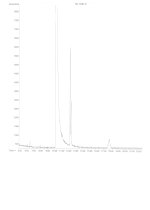coaxingpixies
Rising Star
Species: Mimosa hostilis
Plant Material: 'Inner Rootbark'
150g Rootbark
75g NaOH
1L Distilled Water
200mL Naptha
Constituents Isolated:
(NN-DMT) N,N-Dimethltryptamine
(2-Me-THbetaC) 2-Methyltetrahydro-.beta-carboline
(Naptha) 2-Acetyle-6-methoxynapthalene
The mass spec shows a few guesses for the secondary compound, and upon basic research the .beta-carboline was chosen instead of the .gamma-carboline.
Mass spec occured within 1 week of extraction, evaporated under room temperature airflow, samples were refrigerated during storage.
-----------------------------------------------------------------------------
2-Me-THbetaC

 en.wikipedia.org
en.wikipedia.org

 www.ncbi.nlm.nih.gov
www.ncbi.nlm.nih.gov
-----------------------------
Some other things to consider:
The information presented above is based entirely on empirical, scientific observations.
Another possibility is that the beta-carboline is a degradation product of a higher mass alkaloid such as Yuremamine.

 en.wikipedia.org
en.wikipedia.org
It should be noted that this is currently considered a 'novel' compound and in three years has yet to be reproduced.
Vepsäläinen, J. J.; Auriola, S.; Tukiainen, M.; Ropponen, N. & Callaway, J. (2005). "Isolation and characterization of Yuremamine, a new phytoindole". Planta Medica 71(11): 1049-1053.
Plant Material: 'Inner Rootbark'
150g Rootbark
75g NaOH
1L Distilled Water
200mL Naptha
Constituents Isolated:
(NN-DMT) N,N-Dimethltryptamine
(2-Me-THbetaC) 2-Methyltetrahydro-.beta-carboline
(Naptha) 2-Acetyle-6-methoxynapthalene
The mass spec shows a few guesses for the secondary compound, and upon basic research the .beta-carboline was chosen instead of the .gamma-carboline.
Mass spec occured within 1 week of extraction, evaporated under room temperature airflow, samples were refrigerated during storage.
-----------------------------------------------------------------------------
2-Me-THbetaC

β-Carboline - Wikipedia

Tetrahydro-beta-carbolines, potential neuroactive alkaloids, in chocolate and cocoa - PubMed
Tetrahydro-beta-carbolines (THbetaCs), potential neuroactive alkaloids, were found in chocolate and cocoa. 6-Hydroxy-1-methyl-1,2, 3,4-tetrahydro-beta-carboline (6OHMTHbetaC), 1,2,3, 4-tetrahydro-beta-carboline-3-carboxylic acid (THCA), 1-methyl-1,2,3, 4-tetrahydro-beta-carboline-3-carboxylic...
-----------------------------
Some other things to consider:
The information presented above is based entirely on empirical, scientific observations.
Another possibility is that the beta-carboline is a degradation product of a higher mass alkaloid such as Yuremamine.

Yuremamine - Wikipedia
It should be noted that this is currently considered a 'novel' compound and in three years has yet to be reproduced.
Vepsäläinen, J. J.; Auriola, S.; Tukiainen, M.; Ropponen, N. & Callaway, J. (2005). "Isolation and characterization of Yuremamine, a new phytoindole". Planta Medica 71(11): 1049-1053.
Attachments
-
 Mimosa_hostilis-STB-NaOH-Naptha-_-2-Methyltetrahydro-beta-carboline-_-1of5.jpg175.7 KB · Views: 0
Mimosa_hostilis-STB-NaOH-Naptha-_-2-Methyltetrahydro-beta-carboline-_-1of5.jpg175.7 KB · Views: 0 -
 Mimosa_hostilis-STB-NaOH-Naptha-_-2-Methyltetrahydro-beta-carboline-_-2of5.jpg180.1 KB · Views: 0
Mimosa_hostilis-STB-NaOH-Naptha-_-2-Methyltetrahydro-beta-carboline-_-2of5.jpg180.1 KB · Views: 0 -
 Mimosa_hostilis-STB-NaOH-Naptha-_-2-Methyltetrahydro-beta-carboline-_-3of5.jpg900.9 KB · Views: 0
Mimosa_hostilis-STB-NaOH-Naptha-_-2-Methyltetrahydro-beta-carboline-_-3of5.jpg900.9 KB · Views: 0 -
 Mimosa_hostilis-STB-NaOH-Naptha-_-2-Methyltetrahydro-beta-carboline-_-4of5.jpg897 KB · Views: 0
Mimosa_hostilis-STB-NaOH-Naptha-_-2-Methyltetrahydro-beta-carboline-_-4of5.jpg897 KB · Views: 0 -
 Mimosa_hostilis-STB-NaOH-Naptha-_-2-Methyltetrahydro-beta-carboline-_-5of5.jpg888.5 KB · Views: 0
Mimosa_hostilis-STB-NaOH-Naptha-_-2-Methyltetrahydro-beta-carboline-_-5of5.jpg888.5 KB · Views: 0
